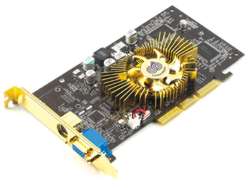 |
|
Chaintech GeForce4 MX440 - (Golden Package) |
|
|
Price : $138($320NZ, $260AU) | |
|
Reviewed by: Techfreak | |
|
Date : March 16th 2002 | |
Brute force is the name of the game, and nVidia is the main player behind this game. Since their incorporation in 1993 nVidia has been the primary force behind revolutionizing the graphics card industry. Even though nVidia released their GeForce 4 GPU only 2 months ago, it is claimed that they had already been ready to launch the NV25 in December 2001. However due to the tremendous success of their GeForce 3 line of GPU's delayed the initial launch of the GeForce 4. The only notable threat to nVidia today is posed by ATI technologies and for some reason they seem to be managing to go head to head with nVidia in almost every aspect.
nVidia released their new GeForce 4 line of GPU's in two flavours, the Titanium line for the high-end performance seekers, the MX series for the budget conscious gamers. When the GeForce 3 GPU was released, it opened up a whole new chapter in the gaming industry with their programmable infiniteFX engine. So has the new GeForce 4 GPU (code named NV25) being incorporated with to replace the Geforce 3? Lets find out�
One of the primary improvements with the GeForce 4 GPU is the inclusion of two vertex shaders. Fact is most vertex shader operations work parallel to each other. As a result having an additional vertex shader will only increase the overall performance. Of course at present we really don't see much games utilizing the full capabilities of the GeForce 4, nevertheless this does not mean game developers will simply sit on their asses and do nothing. So we can expect to see some really cool games which will make full use of this GPU.
For those who are unaware as to what exactly a vertex shader is here's an extract from our GeForce 3 article.
"A 3D image in a scene is brought to life through a complex formation of triangles which in turn makes the 3D object. A triangle is composed of three vertices. A Vertex is where two edges of the triangle meet. A Vertex shader basically adds effects to each vertex adding to the 3D effect of the scene. This procedure involves millions of mathematical calculations and thus is very complex, it needs very fast processors to be able to compute such scenes thus realism in this aspect was limited until the G Force 3 GPU Came along. It incorporates a fully programmable Vertex shader (Embedded in the NFinite FX Engine) with the massive power of the G Force 3 GPU and its 57 million transistors this allows for unprecedented flexibility for game developers who can now develop realistic 3D images, render them real time, and also add specific effect to each vertex using the Nfinite FX Engine. This allows for more complex scenes to rendered as well as to add never before scene affects to 3D scenes, and bring 3D a step closer to reality. You will see examples as you read ahead with our review"
Since the Chaintech card we're reviewing today is a GeForce 4MX 440, we should mention that the GeForce 4 MX chip does not include this second vertex unit, and it's only offered in the Titanium series.
There has been no improvements or any add-ons to the pixel shader, and it remains as it was with the original launch of the GeForce 3. However note the fact that both the Pixel shader and the Vertex shader operate at a higher clock speed than that of the GeForce 3. A pixel needs no introduction. It's basically the smallest element that makes up an image. Pixels determine the look of the image. NVIDIA introduced per pixel shading with the G Force 2 GPU, and the G Force 3 GPU took it to another level. The G Force 3 has a programmable pixel shader which lets the game developer determine how a pixel should be shaded and not the GPU as in traditionally would by selecting the shading from a pre set palette. This sets the stage for images to achieve realism as never before. Now games are limited only by the creative minds of the game developers as opposed to what it was a few years back.
The biggest improvement with regards to the GeForce 4 GPU's performance is obtained by the new Lightening Speed Memory Architecture II. nVidia seems to have optimized their memory architecture to obtain every ounce of memory bandwidth they can get. Here's an extract from the nVidia site to highlight what new improvements have been integrated into the memory architecture.
- A crossbar-based memory controller: Ensures that every aspect of the memory system is balanced and that all memory requests by the graphics processor are handled properly. Under complex loads, LMA II's memory crossbar architecture delivers 2-4 times the memory bandwidth of other standard architectures.
- A Quad Cache memory caching subsystem: High-speed access buffers that store small amounts of data and operate at tremendously high bandwidth, ensuring that data is queued and ready to be written to the memory. These caches are individually optimized for the specific information they deal with, resulting in almost instantaneous retrieval of key data.
- Lossless Z-buffer compression:Reduces Z-buffer traffic-one of the largest consumers of memory bandwidth in a graphics subsystem-by a factor of four, without any reduction in image quality or precision.
- A visibility subsystem:Determines whether or a not a pixel will be visible in a scene. If it determines a pixel will not be visible, the pixel is not rendered, saving valuable frame buffer bandwidth.
- Fast Z-clear technology:Minimizes the time it takes to clear the old data in the Z-buffer, boosting frame rates up to 10% without compromising image quality.
- Auto pre-charge:Warns the memory device of areas of the memory likely to
be used in the very near future, allowing the GPU to spend less time waiting
for memory and more time rendering pixels.
The Quad cache memory caching feature is truly awesome. Right now these caches aren't as big as those in CPU's, however as GPU speeds increase in the future, it's very likely that bigger capacity caches to be included. We might probably see this in nVidia's next GeForce release. I'll be speaking of the rest of the features as we take a close look at the card at hand today.
Chaintech has been in the PC industry for quite some time now. Of course they are mostly known for the range of mainboards they produce. Chaintech may not be the first name that crops into your mind when thinking of buying a graphics card, however I must say first impressions of this card have been very promising indeed. Lets take a close peek at the specifications of the board before we go into the nitty gritty stuff�
| Interface |
|
| Chipset | NVIDIA� GeForce4� MX440 |
| Memory | 64MB DDR SGRAM |
| General features |
|
| High quality video playback |
|
| Special features |
|
| Other features |
Game Bundled: |
- nView Multi-display Technology
Earlier this was known as the Twin-View feature, where you could hook up two monitors and have double the desktop work space from one machine. In essence Twin-View technology and nView do not differ greatly except for the fact that the new nView technology incorporates more customizable desktops and display options to increase user productivity. Sadly however Chaintech's A-G441 does not incorporate this functionality. The card only includes a S-video TV output. So if you're currently on the look out for a dual monitor setup, Chaintech offers this as an optional feature, or you could opt for one of their Titanium family boards, which include all GeForce 4 features.
- Windows� Integration: Seamless integration within the familiar Windows
environment
- Setup Wizard: Enables quick and easy installation of nView
multi-display
- Transparency Effects: Quickly view hidden applications on cluttered
desktops
- Microsoft Internet Explorer� Extension: Enables more efficient web
searches
- Hot keys: Bind every nView action to a keyboard hot key
- Advanced zoom features: Quickly enlarge portions of the screen to view
information easier and to do precision editing
- Desktop management: Create up to 32 different Windows desktop
workspaces to control information flow
- Window and application management: Gives users full control over repositioning dialog boxes and application windows
- Accuview Antialiasing
This time nVidia has made the Anti Aliasing engine much bigger than what we saw in the GeForce 3, and they call it the Accuview Anti Alaising Engine. Having a bigger anti aliasing engine means that we're able to enjoy high-resolution anti aliasing without experiencing any drops in performance. We shall see how true this is in our tests.
Here's a picture of the Anti Aliasing engine at work.
|
From nVIdia |
The first thing that captures your eye as you get hold of the box is the lovely golden color heatsink covering the GPU. Chaintech has even painted the cooling fan gold. It's a real eye catcher I must admit. First let me tell you what is offered with the card. Along with the card comes a s-video cable for TV-output. Playing a game of NFS5 or ColinMcray's Rally can give you totally different experience when playing it on your big screen TV.
 |
 |
 |
Furthermore Chaintech packs in a nice software bundle as well. So from the moment you get your hands on the card you're ready to rock. The main CD comes with all the drivers, DirectX 8.1, Intervideo's WINDVD and 3D Deep. The drivers included are nVidia 27.00 detonator drivers, so you might want to download the latest version from the nVidia site. They also include a copy of MDK 2 and AquaNox as well. I'm not the greatest fans of these genre of games, nevertheless the software bundle is decent by all means.
 |
The card includes four 16MB DDR SDRAM chips, and it's clocked at 200MHz (DDR). One thing lacking is any kind of memory sinks protecting from heat, however considering this is a MX series we won't expect them to heat up as much. Since the card we're reviewing is the Golden sample Chaintech offers, they seem to have applied gold in every possible location. Even the mounting unit has been gold plated; hands down it really looks very cool.
Alright time to see what this card can do. We got hold of a range of cards for this test. One of the 1st GeForce 3 cards, the Visiontek GeForce 3, 3D Prophet II Titanium, Gigabyte GeForce2 MX400, ATI Radeon 8500 and a nVidia GeForce 4 Ti4600. expect some of these reviews shortly as well. All tests were initially done with no overclocking. The Chaintech GeForce4 MX has a clock setting of 270/400MHz standard.
| CPU | Athlon XP 2000+ |
| Mother Boards | SOYO Dragon Plus |
| Memory | 256MB PC2100 |
| Hard Drive | IBM 65GXP 60 GB 7200 RPM |
| Video Card |
|
| Operating System | Windows XP Professional |
Benchmark Software Used.
3D Mark 2001
3D Mark 2001SE
Quake III Arena
Serious
SAM
Unreal
Lets start with 3d Mark 2001
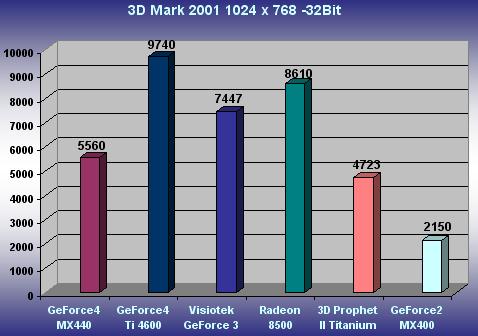 |
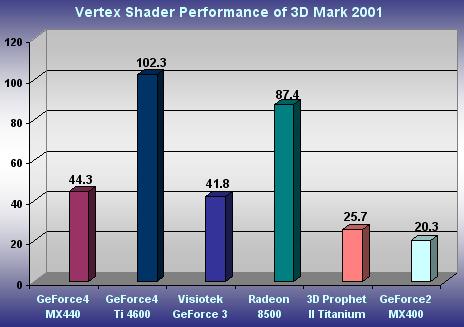 |
We can see the higher clock speeds of the GeForce4 vertex shader really makes
a difference. The Chaintech GeForce4 MX gets a higher score in comparison to the
Visiontek GeForce3. As we all know the GeForce4 MX series was introduced to
replace the aging GeForce 2MX series, and as we can see, the performance
increase is simply amazing.
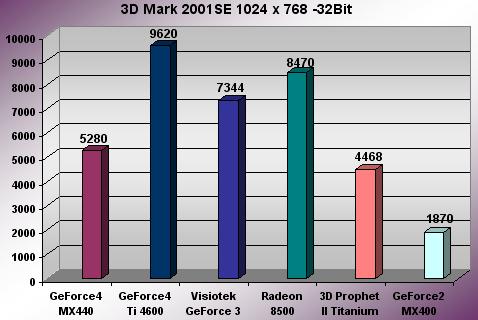 |
Benchmarks Cont'd - Quake III Areana
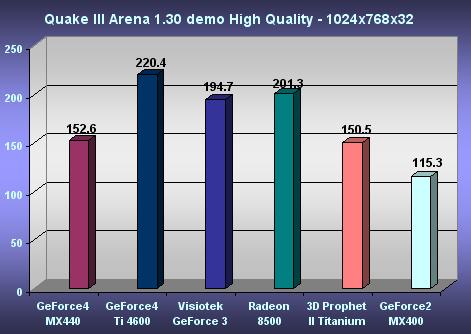 |
For some reason the Chaintech card doesn't perform exceptionally better than the 3D Prophet II Titanium, even though it still has a good lead over the MX400. however you'll see in our next test results that the power of the Geforce4 lies in higher resolutions.
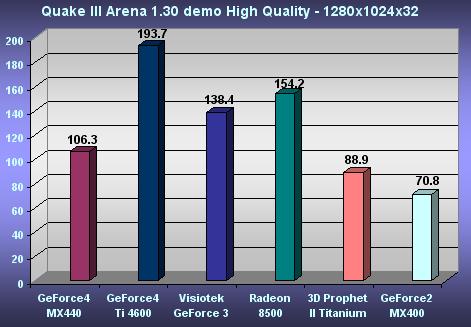 |
As you can see, the GeForce4 cards truly outshine at higher resolutions. Their increased bandwidth really proves to be working.
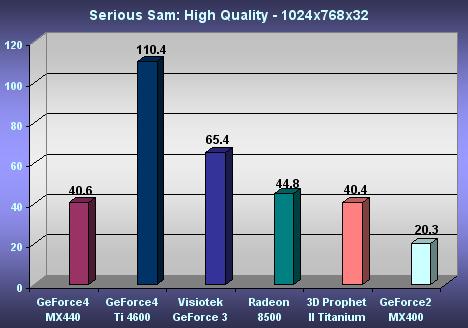 |
Benchmarks Cont'd - Serious Sam
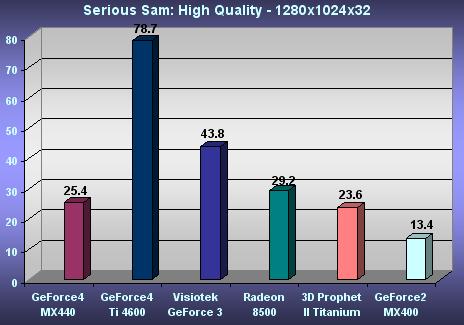 |
Serious Sam seems to be a tough nut to beat for all cards. While most cards performed over 130FPS in Quake III at 1024 x 768 doesn't seem to be able to go beyond 110FPS. Nevertheless the GeForce 4 MX is still well ahead of the GeForce 2 MX 400 which is very impressive.
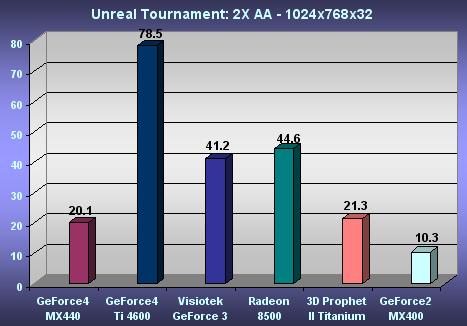 |
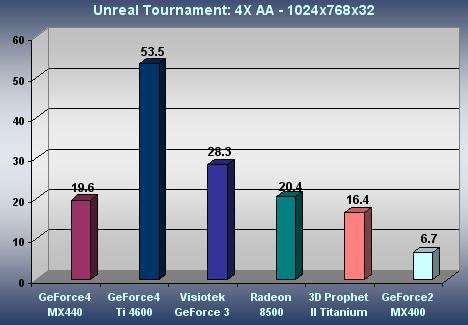 |
nVidia's new advanced Anti Aliasing algorithm is so efficient that even when switched to 4x AA we don't see much of a performance hit. As we can see in the above tests, the contrast is negligible with regards to the GeForce4 MX. Furthermore we see that GeForce2 bases cards seem to get hit more hardly when switched between 2X AA and 4X.
I was able to get the card running at 311Mhz core and 450MHz Memory. Increasing the memory above this point resulted in complications, which means this is more likely to be the limit of the card. However every card manufactured differs from one another, so you might get luckier. The core seems be able to take higher clock speeds as at the end I was doing 320Mhz with no problems at all.
Considering the GeForce4 MX was introduced as a value card to replace the GeForce 2MX, this is an exceptional card. Looking at the benchmark results one simply cannot ignore the fact that the Chaintech GeForce4 MX performs incredibly well. I know some of you're under the misconception that any GeForce4 based card will outperform a GeForce3. This is not the case. So if you're looking for good performance a GeForce 3 will always out do a GeForce4 MX card any day. However the intended audience for the GeForce4 MX are budget conscious folk looking for a decent gaming rig, and for them, the GeForce4 MX is certainly the best buy out there right now. Offered at the price tag of around $138US (Approx AU$260) these cards are priced just right. So if you're currently looking to build a budget gaming system, or a replacement for your GeForce 2MX, look no further, these are the best value for money cards you can get right now in the market.
| Table of Contents | ||
|
|
